Nandini D
Everyone wishes to be happy and healthy. Gardening is a simple way of achieving both health and happiness. It can be taken up by anyone at any age. Gardening enhances awareness of one’s surroundings, improves cognitive skills and provides an opportunity to appreciate nature, especially since most of us live in urban jungles. While eco-clubs and nutrition gardens are slowly making their way into schools, many are still unaware of the benefits of gardening. Therefore, Teacher Plus brings you a monthly column on gardening. Articles in this column will provide information about common plants and their use in daily life. Each article will focus on a set of activities and provide a broader scope for learning.
I called Madhavi to enquire about visiting Uma’s house. “Yes, we can go there on Tuesday morning, later we can visit the nursery. You get ready by 8 am. I will inform Sujatha also,” she said and disconnected the phone.

Uma waved at us when she saw us arrive. “I am taking care of my neighbour’s puppies today as they are busy with some work,” she said as she opened the gate. The puppies rushed out and jumped on us.
I noticed lush green plants inside the compound. She had creatively used some plants and artefacts to beautify the place.
Uma offered us salad and fruits. “Please take. Generally, the garden decides what I can cook for the day. I rarely buy vegetables from the market.”
“This is the best,” Sujatha appreciated Uma.
“Madhavi informed me that you are all interested in gardening. Children are also ready to join hands with you. It is good since as a family you can maintain the garden and enjoy the harvest,” said Uma.
“Are these sprouts, carrots, and bananas from your garden?” Shilpa asked.
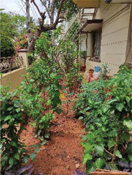
“Yes, only the oranges are from Nagpur, my sister got them yesterday,” Uma replied.
“Do you grow plaintain also? You must have a large area to be able to accommodate big plants!” said Shilpa.
Uma said, “Not much, but I have tried to accommodate as many as I could.”
“I noticed the front side of your house. You have hibiscus, turmeric, rosemary and ruta,” I said.
“Ruta is good for cold related problems. There is great demand from my neighbours for its leaves.”
“During her daily prayers, my mom needs flowers, so I got different shades of hibiscus. They also add to the beauty on the front side of the house. Just two days ago, I pruned them all. The plants were almost touching the roof,” Uma replied.
“I see giloy and skeleton plant on the staircase,” said Anand.
“Oh! you know these plants? Every day we make ‘kashaya’ of giloy and sometimes my mom prepares chutney from the skeleton plant, we call it Mangaravalli in Kannada,” said Uma.
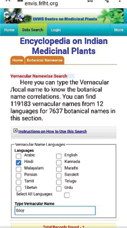
“Different names for the same plant, that is why botanical names are used to confirm the identity, is it not, Nandini?” Madhavi asked.
“Yes, if you wish to know the medicinal plant names, you can search in this database. You can search names in 12 different languages,” I showed the website on my cell phone.
“Aunty, look here, there are many photos of plants with their names and on the ‘Children’s page’ also,” said Vivan.
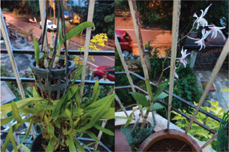
Uma called, “Now let us go out and see the plants. We will go from this side.” She showed us the way to terrace.
“Orchids! It is flowering. You found a place on the staircase grill,” said Sujatha.
“You know it requires less space. We just provide a shelter with charcoal and wood pieces. I got some orchids and ferns from the Western Ghats. One of my friends has a coffee plantation there,” replied Uma.
“This is some vacant place between the houses. I informed the neighbours, before keeping plants and gardening tools. It has become like a nursery now. I do all my experiments here.” Uma showed the place and started explaining.
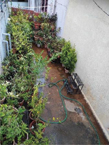
“Initially I tried with small and easy to grow plants. Then I tried with custard apple, banana, sapota, and papaya.”
“Now you can see capsicum, brinjal, rajgira, some radish seeds are sown here.”
“We fixed a net in some portions, to avoid excess sunlight. You know, it is difficult for young plants to survive during summer.”
“As we have less space, I use these pillar bags to grow different vegetables. I planted leafy vegetables at the lower side and you can see brinjal at the top.”

“This is something difficult to believe, See how many different vegetables!” Shilpa screamed.
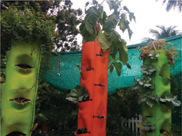
“Here we are keeping some pots on the corner stand, a combination of flowering, aromatic, ornamental plants.” Uma took us to the terrace corner.
“Oh! what a beautiful scene, you have not left any area vacant!” Madhavi said.
“This is amazing! How did you get this idea?” I asked Uma.
“I attended some workshops organized by the Horticulture department. Generally, you can find training related information on their website. I am also part of an organic terrace gardening group. We exchange ideas, seeds, plants,” she replied.
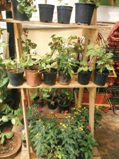
“Come, we will go to the backyard now.” We all followed Uma.
She looked towards the fence, “I found this wooden fence in an antique shop, I painted it and fixed it here. This frame is sturdy, so I could hang some pots.”
Madhavi asked, “All plants are bright and healthy. How do you avoid bugs and flies?”
“Madhavi, bugs are part of Nature. If I notice, I remove the affected leaf or twig. In case I find some infection, I spray neem oil. Look, I installed some bugs here.” She pointed to the painted stones. All laughed.
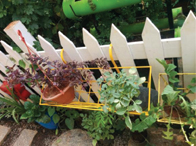
“Very nice, you are creative aunty, I want to have this kind of garden. What all I can grow?” Rina asked.
“Yes, dear, you need to check how much open area you have, where you get partial sunlight, do you have a staircase with railing, balcony and so on. You can think about planting flowering climbers on the compound railing. Otherwise you can try to grow it vertically.”
Madhavi asked Uma, “What precautions do we need to take if we wish to have indoor plants?”

“When you think of keeping plants inside the compound or in the corridor or even in the balcony, you should leave sufficient space for movement. Plants or pots should not become obstacles. If you have infants, pets avoid Alocasia and Cactus kind of plants.”
“You can keep some artifacts and arrange pots on and around that. Plants grow, flower, fruit and die. There will be seasonal variations.”
“For example, some plants like land lillies and dahlia flower only during the rainy season. Nelabevu, what do you call it Nandini?” Uma asked.
“Chirata, Kalmegh (Andrographis),” I replied.
Uma said, “Its decoction is very good for fever. It has a short life. We have to sow seeds again if we want to grow it again. It is necessary to fill soil and manure regularly for potted plants. We should keep watching and working with plants to maintain them.”
“Nowadays growbags are available. They are light weight and come in different sizes,” I added.
“Great information, Uma. We may come back again to discuss with you,” Madhavi thanked her.
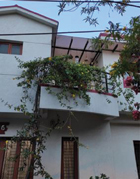
“Wait, take some oranges, these are very tasty,” Uma offered us oranges.
“Oh! these are from Nagpur. Very special,” I said
“How are they special?”Anand asked.
“It is famous, certified as Nagpur Orange, by Geographical Indications (GI) Registry, India,” I replied.
“Then what about Coorg oranges? They are also famous.” Sujatha added.
“Coorg oranges, Arunachal oranges are also registered GIs.”
Anand asked, “Why are they registered? What about other fruits?”
I tried to explain. “You must have heard about famous goods, like Mysore Jasmine, Mysore Silk, Tirupathi Laddu, Alphonso Mango, they are all GI tagged. The distinctivenesss of goods or produce refers to the geographical area of production. People residing in that area for many generations must have contributed to the development of that product. The natural conditions like soil, water have contributed to the taste or aroma.”
“That is how these oranges are special. Henceforth, I will look for such items when I get a chance to travel,”said Shilpa.
“I also look for special GI goods, can we grow GI plants in our house?” Anand asked.
I replied, “You can try dear, but it will not become a GI product.”
Ha, ha, ha… everyone laughed.
Suggested Activities
- Make a sketch for your home garden.
- What are the different components you wish to include in your garden.
Bibliography
- NM Ganesh Babu, Geetha Suresh and K Haridasan, 2010, Secrets of Ethno Medicinal Gardens, FRLHT, Bangalore
- http://envis.frlht.org/
- https://ipindia.gov.in/about-us-gi.htm
The author is a botanist. She has been involved in teaching and research for more than 25 years. Currently she is a consultant for We Care Society (WCS), Bengaluru and visiting faculty RIWATCH, Roing, Arunachal Pradesh. She can be reached at nandinidholepat@gamil.com.
